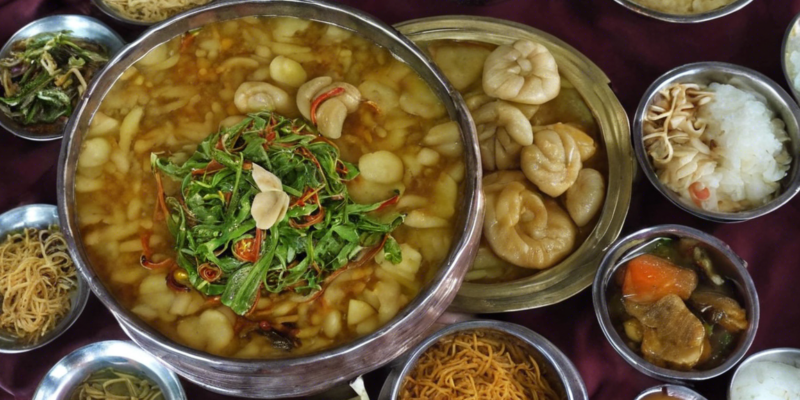Nestled in the pristine beauty of the Himalayas lies the enchanting state of Sikkim, renowned for its breathtaking landscapes, vibrant culture, and delectable cuisine. Blessed with a unique blend of Nepalese, Tibetan, and Bhutanese influences, Sikkimese cuisine is a treasure trove of flavors and aromas waiting to be discovered. In this blog post, we will take you on a culinary journey through the gastronomic wonders of Sikkim, from traditional dishes to local ingredients and dining customs.
The Essence of Sikkimese Cuisine
Sikkimese cuisine reflects the diverse ethnic groups that call the region home, each contributing their own flavors and cooking techniques to the culinary tapestry of the state. One of the defining characteristics of Sikkimese cuisine is its emphasis on fresh, organic ingredients sourced from the region’s fertile lands. Rice, barley, buckwheat, and maize are staples in the Sikkimese diet, often served with hearty vegetable or meat-based dishes.
Traditional Sikkimese Dishes
1. Gundruk
A popular fermented dish made from leafy greens such as spinach or mustard leaves, Gundruk is a tangy and nutritious accompaniment to any meal. It is often sautéed with onions, garlic, and chilies for added flavor.
2. Thukpa
Thukpa is a beloved noodle soup that originated in Tibet but has found a permanent place in Sikkimese cuisine. Made with homemade noodles, vegetables, and meat or soya chunks, this soul-warming dish is a favorite during the chilly winter months.
3. Phagshapa
A hearty pork dish, Phagshapa consists of slices of pork belly cooked with radishes, chilies, and dried turnip greens. The result is a flavorful stew that pairs perfectly with steamed rice.
4. Momos
No journey through Sikkimese cuisine is complete without indulging in a plate of steaming momos. These dumplings are typically filled with minced meat, vegetables, or cheese, and served with a side of spicy tomato chutney.
5. Sael Roti
A traditional Sikkimese bread, Sael Roti is a deep-fried delicacy made from a mixture of rice flour, banana, and sugar. It is often enjoyed during festive occasions and special celebrations.
Local Ingredients and Flavors
Sikkim’s rich biodiversity provides a cornucopia of fresh ingredients that elevate its cuisine to unparalleled heights. Cardamom, ginger, turmeric, and chilies are commonly used spices that impart warmth and depth to Sikkimese dishes. The region’s organic farms also produce an array of fruits and vegetables, including kiwi, plums, pumpkins, and bitter gourds.
Dining Customs in Sikkim
Hospitality lies at the heart of Sikkimese culture, and this is evident in the dining customs observed in the region. Sharing meals is a common practice, with families and communities coming together to enjoy feasts prepared with love and care. It is considered polite to accept seconds or thirds when offered, as it is a sign of appreciation for the host’s cooking.
FAQs
1. What are the must-try dishes for first-time visitors to Sikkim?
For first-time visitors to Sikkim, some must-try dishes include momos, Thukpa, Gundruk, and Phagshapa. These dishes encapsulate the essence of Sikkimese cuisine and are sure to delight your taste buds.
2. Is Sikkimese cuisine suitable for vegetarians?
Yes, Sikkimese cuisine offers a variety of vegetarian options, including vegetable Thukpa, Aloo dum, Chhurpi soup, and Nettle soup. Vegetarians can enjoy a diverse range of flavorful dishes in Sikkim.
3. What are some popular local beverages in Sikkim?
Sikkim is known for its refreshing traditional beverages, such as Chhang (a fermented millet drink), Tongba (a hot millet-based alcoholic beverage), and Chaang (a sweetened local beer).
4. Are there any dessert specialties in Sikkimese cuisine?
Sikkimese cuisine boasts a delectable range of desserts, including Gya Khapse (fried cookies), Khapse (deep-fried pastries), Phini (a sweet, flaky dessert), and Sel Roti (sweet rice bread).
5. How can I experience traditional Sikkimese dining customs firsthand?
To experience traditional Sikkimese dining customs firsthand, consider visiting a local home-stay or participating in a community feast. Engaging with locals and sharing a meal with them is a wonderful way to immerse yourself in the rich culinary heritage of Sikkim.
In Conclusion
Sikkimese cuisine is a testament to the region’s vibrant culture, rich heritage, and deep connection to the land. Whether you are savoring a bowl of piping hot Thukpa on a chilly evening or delighting in the crispy goodness of Sael Roti during a festive celebration, each dish tells a story of tradition, flavor, and community. So, the next time you find yourself in the enchanting land of Sikkim, be sure to explore its culinary delights and embark on a gastronomic adventure like no other.

